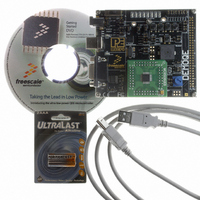DEMO9S08QE8 Freescale Semiconductor, DEMO9S08QE8 Datasheet - Page 5

DEMO9S08QE8
Manufacturer Part Number
DEMO9S08QE8
Description
BOARD DEMO FOR MC9S08Q
Manufacturer
Freescale Semiconductor
Series
Flexis™r
Type
MCUr
Datasheets
1.DEMO9S08QE8.pdf
(6 pages)
2.DEMO9S08QE8.pdf
(41 pages)
3.DEMO9S08QE8.pdf
(3 pages)
4.DEMO9S08QE8.pdf
(2 pages)
Specifications of DEMO9S08QE8
Contents
Demo Board
Silicon Manufacturer
Freescale
Core Architecture
HCS08
Core Sub-architecture
HCS08
Silicon Core Number
MC9S08
Silicon Family Name
Flexis - S08QE
Rohs Compliant
Yes
For Use With/related Products
MC9S08QE8
For Use With
DEMOACEX - BOARD EXPANSION FOR DEMO KIT
Lead Free Status / RoHS Status
Lead free / RoHS Compliant
Connect Board to Computer
USB driver installation is a one-time required
step that requires CodeWarrior installation first.
1. Remove board from anti-static pouch.
2. Connect provided USB cable from a
3. Operating system will recognize your board
4. Follow on-screen instructions until all USB
Test Board by Running
Quick Start Application
Now that you have successfully completed
the software and hardware setup, test your
board by running the Quick Start Application
pre-loaded in the microcontroller’s on-chip
flash memory.
The programmed application samples the
microcontroller’s general-purpose input pins
connected to push buttons to perform two
actions. The first action is to illuminate
The green 8-bit MC9S08QE8 daughter card
will be mounted on the base board.
free USB port on your computer to the
USB connector on the board.
as new hardware and will prompt you to
install the USB drivers. Choose recommended
option to install the software automatically.
USB drivers for your board were pre-loaded in
CodeWarrior installation.
driver installations are complete. The green
USB LED on-board should illuminate.
STEP
STEP
3
4
Accelerometer Demo
LED with a general-purpose output pin.
The second action is to play a tone per push
button on the speaker using a pulse-width
modulated signal programmed at different
frequencies. Last, the application samples
the potentiometer using the microcontroller’s
analog-to-digital converter and uses the
result to vary the light intensity of an LED
by changing their pulse-width modulated
signal’s duty cycle.
1. Turn the SYSTEM POWER switch to the
2. Press push buttons labeled PTA2, PTA3. A tone
3. Rotate potentiometer to vary light intensity
4. Now that your board is functional, try out the
ON position. The red POWER LED will illuminate
and application will start.
will be emitted from speaker when each push
button is pressed, and the LED labeled PTC0
will illuminate, while LEDs labeled PTC[2:3]
and PTC[4:5] turn off respectively.
of the LED labeled PTC1.
provided labs in the DEMO9S08QE8 Labs
document to learn more about the ultra-low
power MC9S08QE8 microcontroller and
other features included with your board.











